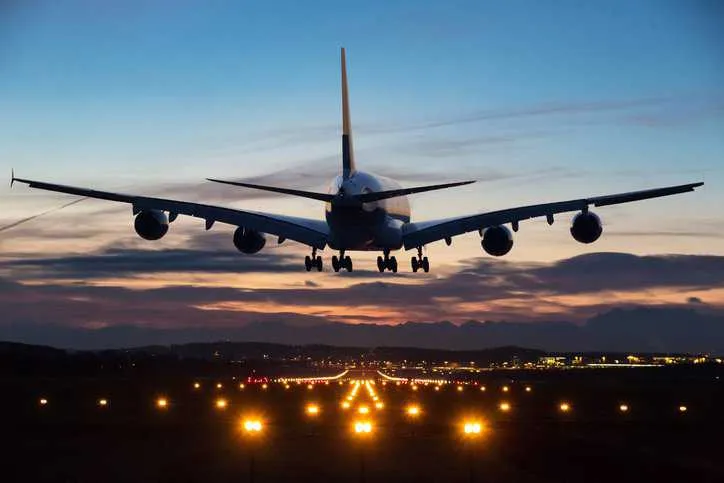ANSI/IES RP-37-22: Lighting Airport Outdoor Environments

Airport lighting is one of the most important parts of safe management of air traffic. If an airport provides flight operation, it must be equipped with the lighting system, as it assists pilots and the ground crew to land and takeoff safely, especially at night or in low visibility conditions. ANSI/IES RP-37-22: Recommended Practice— Lighting Airport Outdoor Environments provides guidance for a safe lighted environment for aircraft servicing and for pedestrian and vehicular movement in and around the airport environment.
What Is the Importance of Airport Lighting?
Visibility plays a role in ensuring safety at airports. During adverse weather conditions, airport lighting helps pilots effectively identify crucial areas, such as the runway and taxiway, within airport premises. Lighting is extremely important to prevent accidents on runways and guide pilots during moments like takeoff, landing, and taxiing. Lighting systems also aid in obstacle identification and avoidance, which is crucial for preventing accidents. Luckily, standards like ANSI/IES RP-37-22 exist in helping assure efficiency and quality in airport lighting systems.
What Is ANSI/IES RP-37-22?
ANSI/IES RP-37-22 is a guide for the planning and design of lighting systems in the entire airport outdoor environment. The American National Standard has been prepared as a guide for the application of fixed outdoor lighting in and around the airport environment with respect to the airport’s special requirements. The requirements include height restrictions (obstructions affecting navigable airspace), the ability to distinguish color of light for visual cues, prevention of light trespass that may interfere with the vision of pilots or air traffic control tower (ATCT) personnel, air traffic controllers’ ability to see approaching aircraft and aircraft performing ground operations within the “aircraft movement area” without glare or direct or indirect light trespass, and Pilots’ ability to detect runway lighting without glare or direct or indirect light trespass.
ANSI/IES RP-37-22 provides recommendations for three airport-related applications:
- For airside applications: Provide for adequately lighted areas where parked aircraft are safely serviced, where aircraft crew and passengers safely board and deplane, and where cargo operations are conducted.
- For landside applications: Provide for adequately lighted departure and arrival areas, walkways to the terminal, secure staffed access points, and vehicle transaction areas for safety and security of pedestrians and vehicles.
- For adjacent development applications: Provide guidance for lighting in the vicinity of the airport (including areas outside the airport property line), while also considering the special needs of the airport environment, such as height restrictions and potential light interference with air traffic controller and/or pilot vision.
Airport Runway Lights
The critical part of airport lighting system is runway lights, which should be clearly visible and work continuously in all operation conditions. Runway has special markings identifying beginning and end of a runway, touchdown point, location of a runway, etc. At night, however, these markings are not visible for pilots. Consequently, the airport runway is additionally illuminated with runway lighting.
Types of Airfield Runway Lights
The lights on a runway are of different types. Each type of runway light has its own meaning and function:
- Approach lights are the first lights that pilot will “reach” during landing and “show” the direction of the runway. They are located prior to the runway. Approach lights are of white color, unidirectional, blinking, or steady type of lights.
- Runway End Identification Light [Runway Threshold Identification Light (RTIL)] is a white flashing light, unidirectional, that identifies beginning of a runway. Unlike approach lights, there only two RTIL lights installed per one side of a runway.
- Threshold Lights are green color airfield lights, unidirectional type, installed at the beginning of the part of a runway where aircraft can do touchdown. Threshold is not a touchdown point yet. but this is a beginning of “safe-to-land” part of a runway.
- Runway edge lights are the most important lights on the airfield. They are located on the left and right sides of a runway (edges) and illuminate the part of the runway safe for landings. Runway edge lights are of different colors, and usually they are bidirectional. The most often used are white/white lights and also can be white/yellow, white/red, and yellow/red. Such differentiation of colors of runway edge lights is explained by the category of a runway, its length, and other factors.
- Runway end lights identify the end of a runway. They are unidirectional red color aviation lights. Airports often use runway threshold end lights, a bidirectional green/red airfield light. From one direction it is green, from the other direction it is red. Threshold end lights are installed on the runways having threshold and runway end in the same location.
- Taxiway lights are blue color airfield lights installed on taxiways, and aprons. Taxiway is a part of airfield where aircraft is moving after landing to a runway. Taxiway lights are not so bright comparing to runway edge or threshold lights, and they are almost invisible from the air.
- PAPI Lights (Precision Approach Path Indicator lights) are bicolor lights that help a pilot to keep the correct path when approaching airport runway. They are located on the left and right side of the runway. Each PAPI light usually consists of four lighting fixtures (4 x Light House Assemblies). Each lighting unit can provide red or white light output. If aircraft is too low to the ground, all four lights will be of red color. If aircraft is too high, all 4 lights will be of white color. Thus, the correct path is when two lights are white and two lights are red.
ANSI/IES RP-37-22: Recommended Practice— Lighting Airport Outdoor Environments is available on the ANSI Webstore.







Thanks for sharing your knowledgeable content with us. Impressed with the precision and creativity of the outdoor lighting installers—my garden looks stunning.